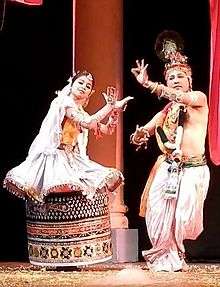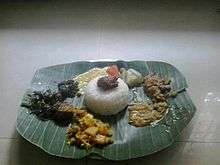Bisnupriya Manipuri people
The Bishnupriya Manipuris are a group of Indo-Aryan people live mainly in parts of Manipur, Assam, Tripura and Bangladesh. They are Kshatriyas. They speak a language of Indo-Aryan origin which is quite different from Bengali or Assamese. The most distinctive feature of the language is it replete with Tibetan-Burmese (Meitei) elements. The culture of the people is almost identical with that of the Meiteis, with the exception of a few folk practices which are prevalent among the Meiteis.
Culture
The religious customs and traditions of Bishnupriya Manipuris are unique. They are organized in such a manner that in temple institutions those reveal the real festivity and reflect the curious character of socio-religious life of the valley.
Fine Arts: During the reign of king Bhagya Chandra, towards the 18th century, Vaishnavism became very popular in Manipur. As a result, Vaishnav Palakirtan with Mridanga and Kartalaa became the most prominent factor in Bishnupriya manipuri fine arts. Rasleela is the most important aspect of their culture. Here in Ras-dance the philosophy of the manipuris is the basis on which the philosophy of the Vaisnavism is the body and plot of the dances with the essence of the Bhagavata philosophy.
Festivals: To Bishnupriya Manipuris, festivals are the symbols of their cultural, social and religious aspirations which, besides removing the monotony of life by providing physical diversions, mental recreation and emotional outlet, help them lead a better and fuller life. Bishu, Rathyatra or Kang-Festival, Kartika festival, Maharas Purnima, Phaguwa or yaosang festival etc. are their major festivals.

Marriage: Marriage in society is based on the Hindu pattern and mostly Aryan and non-Aryan elements having certain traditional customs. Marriage is restricted within the gutros in BPM community.
Food: Rice, vegetable and fish are principle foodstuffs of both the Bishnupriyas. Meat and alcohol is strictly prohibited in the society. In religious and social feasts even fish is never used.

Dress and Ornaments: Traditional dress used by the men is called Pachhati - about five feet long cloth manufactured by themselves which worn round the waist. Women usually wear blouses with traditional Lahing/Fanek or Chakshabi (a coarse cloth with lengthwise stripes and embroidered on both sides lengthwise) with an Enaphi (Single or multicolor coarse cloth with laces on both ends) and an Angei or blouse.
Religion and observances: Mass propagation of Hindu customs and traditions in the society is the indicator of their reverence towards the Hindu deities and temples.
- Bishnupriya Manipuri caste is divided into two parts or classes- one is called Rajargang and the other one is known as Madoigang. The group Madoigang mainly inhabit Kamalpur, India.
Notable people
- Guru Bipin Singh was a director, choreographer and teacher of Manipuri dance.
- Mairembam Koireng Singh was the first elected Chief Minister of Manipur, India, and a freedom fighter during the Second World War.
- Justice Surendra Kumar Sinha, current Chief Justice of Bangladesh
- Ms. Manoshi Sinha, editor and writer, Tinsukia, Assam / Ghaziabad, Uttar Pradesh, India